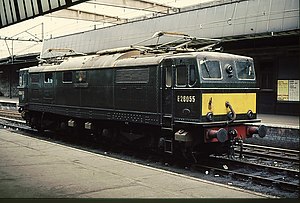British Rail Class 76

Locomotive no. E26055 at Sheffield Victoria in 1969.
|
|||||||||||||||||||||||||||
|
|||||||||||||||||||||||||||
|
|||||||||||||||||||||||||||
|
|||||||||||||||||||||||||||
|
|||||||||||||||||||||||||||
| Type and origin | |
|---|---|
| Power type | Electric |
| Builder | LNER Doncaster Works (prototype) BR Gorton Works |
| Serial number | Doncaster 1914 Gorton 1008–1064 |
| Build date | 1941 (prototype), 1950–1953 |
| Total produced | 58 |
| Specifications | |
|---|---|
| Configuration | Bo-Bo |
| AAR wheel arr. | B-B |
| UIC class | Bo+Bo |
| Gauge | 4 ft 8 1⁄2 in (1,435 mm) standard gauge |
| Wheel diameter | 4 ft 2 in (1.270 m) |
| Length | 50 ft 4 in (15.34 m) |
| Loco weight | 87 long tons 18 cwt (196,900 lb or 89.3 t) 87 long tons 18 hundredweight (89.3 t; 98.4 short tons) |
| Electric system(s) | 1500V DC Catenary |
| Current collection | Pantograph, 2 off |
| Traction motors | Metropolitan-Vickers 186, 4 off |
| Train heating | Steam generator (14 locomotives) |
| Train brakes | Vacuum, some later Dual Vacuum / Air |
| Performance figures | |
|---|---|
| Maximum speed | 65 mph (105 km/h) |
| Power output |
Continuous: 1,300 hp (969 kW) One-hour: 1,868 hp (1,393 kW) |
| Tractive effort | 45,000 lbf (200,000 N) |
| Loco brakeforce | 72 long tons-force (717 kN) |
| Career | |
|---|---|
| Operators | British Railways |
| Numbers | 26000–26055; later E26000–26057; later 76001–76057 |
| Axle load class | LNER: RA 9 BR: RA 8 |
| Locale | Manchester–Sheffield–Wath line |
| Withdrawn | 1970–1981 |
| Disposition | One preserved, remainder scrapped |
The British Rail Class 76, also known as Class EM1 (Electric Mixed-Traffic 1), is a class of 1.5kV DC, Bo+Bo electric locomotive designed for use on the now-closed Woodhead Line in Northern England.
The prototype, LNER No. 6701 was completed at Doncaster Works in 1941 to a design by Sir Nigel Gresley, but electrification of the Woodhead Route together with construction of 69 similar units was delayed by the Second World War. It was tested on the few sections of 1500 V DC lines owned by the LNER but had not worked any great distance by 1947 when it was loaned to Dutch Railways to help with their post war shortage of locomotives. In September 1945 the LNER assigned it the classification EM1; previously it had been unclassified.
The prototype locomotive, renumbered 6000 in June 1946, remained on Dutch Railways until 1952 when the Woodhead electrification was complete. While in the Netherlands it gained the name Tommy after the nickname given to British soldiers and ran for the rest of its working life with a name plate which included an explanation of the origin - "So named by drivers of the Netherlands State Railway to whom this locomotive was loaned 1947-1952". It was renumbered to 26000 following the formation of British Railways.
When new, the locomotive had Westinghouse air brakes, and dual air and vacuum brakes were provided for the train. For operations in the Netherlands, the vacuum brake equipment was disconnected. When returned to Britain, the vacuum brake was restored but the air brake for the train was removed.
26000 Tommy was used alongside the other EM1 locomotives equipped with train heating boilers, in everyday service. It was withdrawn in March 1970 and scrapped at Crewe two years later, when passenger services were withdrawn over the Woodhead route and several locomotives became surplus to requirements.
...
Wikipedia
